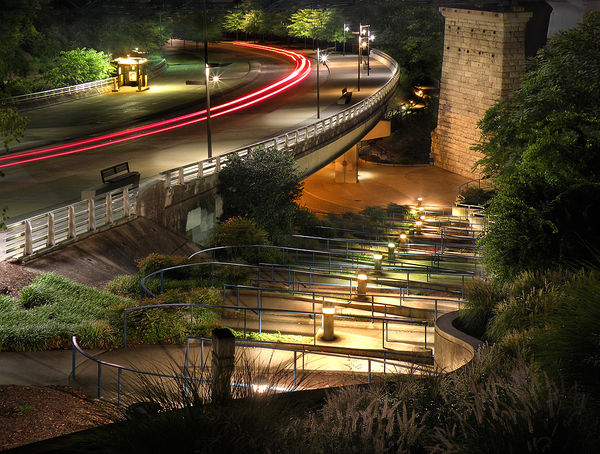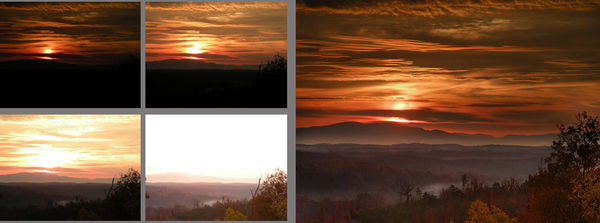Posts for: architect
Mar 16, 2014 11:05:32 #
Feb 13, 2014 22:26:56 #
I could have guessed you age pretty close. I am 72 and make a game of standing on one foot at a time to put my legs through my boxers, and then my socks. When I was 70 I had to sit down to do both. So practice with your balance. I grade myself each morning on my balance. Highest grade so far is a C- on my left foot and a B- on my right, but practice makes perfect.
Feb 11, 2014 12:48:14 #
Welcome bicyclerepairman. I also love my D90. My strong preference for processing RAW files is Adobe Camera RAW, which comes with Photoshop, Lightroom and Photoshop Elements. I have used Nikon NX2, but not Lightroom or Corel Aftershot Pro. I have used other Corel products but they are quite frustrating and slow compared to Photoshop. Try it out first before buying it.
Jan 22, 2014 21:56:13 #
Wahawk wrote:
AWESOME image!! This is truly what HDR is supposed to be!!
Thank you Wahawk. I have tried all the presets in HDR programs and found few (mostly called photo realistic) that could compare with doing it manually using Photoshop Layers and masks. Take more time for sure, but worth it in my opinion.
Jan 21, 2014 23:37:53 #
Wahawk wrote:
Tone-Mapping really isn't HDR
It may give some of the effects but it is a more 'drastic' and some would say 'artistic' rendering.
True HDR is getting the maximum tonal range in a picture without creating the sensational or wild look. A TRUE HDR photo will not jump out at you and say it was HDR, it will just WOW you with the fantastic range of definition and visibility of details in ALL areas of the photo, from the darkest shadows to the brightest highlights.
It may give some of the effects but it is a more 'drastic' and some would say 'artistic' rendering.
True HDR is getting the maximum tonal range in a picture without creating the sensational or wild look. A TRUE HDR photo will not jump out at you and say it was HDR, it will just WOW you with the fantastic range of definition and visibility of details in ALL areas of the photo, from the darkest shadows to the brightest highlights.
High Dynamic Range techniques are only required when the tonal range of the subject runs off the ends of your histogram either on the high side or the low side. That may require multiple exposures for best results in obtaining a full range of values with detail throughout.
Most images do not require it. So called "fake" HDR usually applies to those images that are single images where high or low values are near or are off the ends of the histogram. Those edits can still create excellent images as the "missing" pixels are not the important ones. In my opinion, good HDR edits do not look like HDR techniques were used. The image will retain good detail in both highlight and deep shadows and display a full tonal range from white to black.
The image posted, which you may have seen here before, was taken with a 6 shot, 8 stop spread to capture detail in the lights and the shadows. It was edited using Layers in Photoshop, not using any HDR software.

Jan 21, 2014 13:54:45 #
Anita_1962 wrote:
Again, thank you all for the feedback. I think I will do a little experiment. I am going to print this photo out with both the border and no border and see which one I prefer.
It's going to be displayed up at the cabin so maybe and old timey wooden frame....but we will see what I can find.
:).
It's going to be displayed up at the cabin so maybe and old timey wooden frame....but we will see what I can find.
:).
A REAL old time wooden frame could work great with this image, printed without a frame.
Jan 21, 2014 12:53:34 #
I generally do not like borders or frames, and especially funky or old-timey frames. A very simple thin border in black or white (depending on the image) can occasionally enhance an image. For example, an image with lots of white around the edges can benefit from a thin dark border if the image is to be displayed on a white background.
As for your image, which I think is quite good, it would much better, in my biased opinion, if there was no distracting border or frame.
As for your image, which I think is quite good, it would much better, in my biased opinion, if there was no distracting border or frame.
Jan 10, 2014 20:30:54 #
wilikioti wrote:
Exactly, I had occasion to meet many architects that were perfectionists. That's exactly why I quit working with them.
I agree with Dlevon. I probably would not hire you either because of your negative attitude. What we want from our architectural photographers is to capture our designs from good viewpoints, with an interesting set-up or staging, which we help with or create ourselves, and with optimal lighting, either natural and/or artificial. Architects who spent many, many hours designing a building know what they want to emphasize in the design. A good architectural photographer needs to understand the architect's design intent and work with them to capture it. Great architectural photographers are a very rare species.
Jan 10, 2014 14:50:20 #
Dlevon wrote:
Don't forget the tilt-shift lens. To be critical for good work!
I discussed that briefly earlier. The widest ones from Nikon and Canon are 24 mm, which is OK for a full frame DSLR but at 35 mm equivalent, are not quite wide enough for interior work with the crop frame DSLRs. I used a Nikkor 35 mm PC lens with my film SLR back in the 70's and it was OK for exteriors and model shots, but compromised for interiors. If one uses a very wide angle lens (16 to 24 mm equivalent) and keeps the camera as level as possible to avoid excessive keystoning, perspective correction is easy in Photoshop.
Jan 10, 2014 14:38:59 #
wilikioti wrote:
I would avoid architectural photography for architects. I found that they are the hardest people in the world to please and some think their work is better than it actually is.
Some of us architects are impossible to please, I agree. And the second part is sometimes true also. Doing architectural photography for architects is quite different from doing it for contractors or realtors... usually anyway. Some of them are perfectionists also. :)
Jan 10, 2014 12:22:03 #
Wall-E wrote:
I'm going to assume that this is directed at me, since you didn't use 'Quote Reply'.
We've been around the block on pricing your work several times in just the last month.
Without a WHOLE LOT MORE information than what you gave, anything posted here is pure bunk.
Pricing has so many variables, that a question like your's is meaningless. Sorry I even read it.
We've been around the block on pricing your work several times in just the last month.
Without a WHOLE LOT MORE information than what you gave, anything posted here is pure bunk.
Pricing has so many variables, that a question like your's is meaningless. Sorry I even read it.
Lighten up Wall-E. There is good information on here, not "pure bunk".
Jan 10, 2014 11:55:40 #
Dennis King wrote:
If you are serious about getting into this line of... (show quote)
You are describing what a professional architectural photographer needs to do high end work, primarily for architects. In addition, the skill required might require apprenticeship as well a people skills to interact with the contractor and/or architect. Architectural training is also an advantage to assist in selecting the best point of views and timing for natural light.
If I understand what this job is about, photographing the process of construction at various stages, a DSLR with a wide angle lens, a tripod and some auxiliary lighting along with natural light should do just fine. Especially if this is for a contractor instead of an architect who may have much higher standards.
Jan 10, 2014 11:25:32 #
Dlevon wrote:
That's an impossible question! I'm a retired architect and I used many architectural photographers for my projects! Some them were absolutely superb in showing my buildings in their best light and view. Of course I worked with them in determining what views to have. They got paid the most. Some projects I just needed record photos, and those photographers got paid the least. Only you can determine what you want to charge. If you're good enough at what you do, you'll get it.
I also am a retired architect, and have worked with professional architectural photographers using 4 x 5 view cameras. For the renovation work documentation, a DSLR with a wide angle (I use a Tokina 11-16 mm with my Nikon D90) will do fine. Perspective correction can be done in Photoshop, so a perspective control (tilt/shift) lens is not necessary. They are not very wide angle (Nikon's widest is 24 mm or 36 mm equivalent) and suitable only for full frame cameras, in my opinion.
Developing a list of what the contractor wants to document would be the first thing to do. That will give you AND them an idea of the time requirements, as well as a preliminary description of scope that might allow you to set a fixed price for the job. Otherwise plan on charging by the hour, considering travel, job site time and editing and printing time. I get about $60/ hour for doing real estate work.
Nov 25, 2013 13:48:32 #
prs77 wrote:
Thanks Nekon and Architect. Your advice is great and I see I have a lot to learn. I am president of a photo club with members from beginners to advanced. I will be sure to pass on your advice and how awesome the uhh community is.
You are welcome. There is truly a lot of knowledge to be found here. I think I will go out and buy a gray card to try Nekon's procedure.
Nov 24, 2013 19:31:01 #
prs77 wrote:
What is the dynamic range of different scenes? For example: sunny day, blue sky; or dark alcove of a cathedral or indoor space; or dark scene like the previous with a bright window? I looked back at some pictures and found the blow-out at +2 on sunny day (attached), and at +1.7 in various dark alcoves.
Perhaps +/-1 is enough for most cases? Articles also list +/-2 but when to use this?
Perhaps +/-1 is enough for most cases? Articles also list +/-2 but when to use this?
Here is some information on how dynamic range in DSLR sensors stack up. According to the second website below, the range is from 11 to 14 stops. Presumably in RAW files only. Note that 11 stops is more than Ansel Adams Zone System, which is 10 stops. When I had cameras that only shot Jpeg, I did a lot of HDR edits. Now that I shoot with a Nikon D90, I rarely need to use a full +/-2 stops for a good edit of a very high contrast subject. The key is to get the optimal exposure, as indicated by the histogram, and you may find you do not need either of the bracketed exposures to make a good edit.
http://www.digital-slr-guide.com/dynamic-range.html
http://hdriblog.com/2012/06/18/dynamic-range-of-sensors-june-2012/
Example of a 8 stop HDR from Jpeg files.
